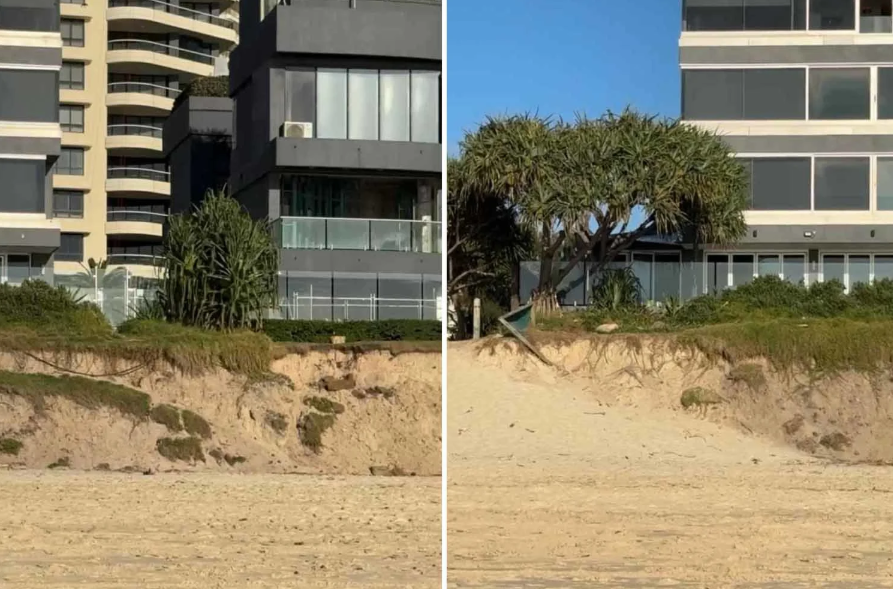
The Gold Coast had seen storms before, but nothing quite like Cyclone Alfred.
Residents woke to a coastline unrecognisable, with beaches carved into six-metre-high sand cliffs.
Millions of cubic metres of sand had vanished overnight, leaving familiar walking paths perilously steep.
Cyclone Alfred struck southeast Queensland in March 2025, the first tropical cyclone to hit the region since Cyclone Zoe in 1974.
Its Category 4 intensity combined with 15-metre-high waves created erosion cliffs along the Gold Coast that experts described as unprecedented.
For Vanissa Livara and her neighbours, the transformation of the shoreline was immediate and dramatic.
Cyclone Alfred’s Massive Impact
Alfred affected 500 kilometres of beach from Coffs Harbour to the Sunshine Coast, gouging millions of cubic metres of sand and marking one of the most significant coastal erosion events in recent Australian history.
Nearly 90 per cent of Australians live within 50 kilometres of the coast, yet many communities had never faced a storm of this scale.
'The beaches have been damaged, but that's preferable to the roads and buildings being damaged.'
The cyclone struck during one of the year's highest tides, amplifying the storm surge and stripping beaches of sand while weakening coastal infrastructure.
Beyond the Gold Coast, Alfred caused power outages affecting nearly 250,000 homes and businesses, one of Queensland's largest outages on record.
Climate Change and Increasing Storm Risks
Climate scientists warned that out-of-zone cyclones—those forming outside traditional tropical areas—were becoming more frequent due to climate change.
Older Australians who purchased coastal properties decades ago faced risks that were once considered unlikely.
Coastal erosion is cumulative, and Dr Kinsela explained that clusters of extreme storms in quick succession worsen damage and slow recovery.
What coastal recovery really meant
- Beach sand would gradually return over months to years
- Dune systems required years to fully recover
- Some sand might never return if washed into deep water
- Full beach restoration expected by 2028 at earliest
Gold Coast City Council spent $1 million annually on beach nourishment, dredging sand from the ocean and pumping it back onto eroded beaches.
Residents like Vanissa questioned whether this offered genuine long-term protection.
While Alfred’s erosion was severe, historical events such as NSW in 1974 or the Gold Coast’s 1967 erosion remained benchmarks for severity, offering some perspective.
Long-Term Coastal Planning and Protection
Nature-based solutions such as dunes, mangroves and oyster reefs were increasingly considered for long-term coastal protection, working with natural systems rather than against them.
The Gold Coast benefited from the world’s largest coastal imaging program, but most other regions lacked long-term monitoring, leaving communities ill-prepared.
Technology allowed real-time tracking and forecasts, but only effective if actively used.
Practical steps for residents included staying off recovering dunes to protect fragile plants, using temporary fencing to trap sand, and re-vegetating dunes to reduce future erosion.
Long-term coastal planning required understanding the impacts of rising sea levels and increasing storm intensity, ensuring that communities remained safe while enjoying seaside living.
As Vanissa and her neighbours watched their beloved beaches slowly recover, their experience served as a stark reminder that the lifestyle benefits of coastal living increasingly came with risks previous generations had never faced.
What This Means For You
Cyclone Alfred caused one of the largest coastal erosion events in recent Australian history, impacting 500 kilometres of beach and leaving many areas unrecognisable.
Full beach restoration would take years, with dunes recovering more slowly and some sand potentially lost permanently, leaving communities exposed to ongoing risks.
Climate change is increasing the frequency of extreme storms, raising long-term concerns for coastal residents and highlighting the importance of preparedness.
Nature-based solutions, long-term monitoring programs, and practical actions by residents are essential for sustainable coastal protection.
For those living by the sea, these developments are particularly relevant—understanding the recovery process and taking proactive steps can help safeguard properties, lifestyle, and peace of mind for years to come.
If you found the challenges of beach recovery after Cyclone Alfred eye-opening, there’s more to explore about local coastal management decisions.
Experts continue to debate the best ways to protect shorelines while balancing environmental impacts and community needs.
This next story highlights a real-life example of how coastal planning choices can stir concern among researchers and residents alike.
Read more: Coastal erosion researcher warns against Gold Coast plan for bars on beaches
Cyclone Alfred—Wikipedia — Overview of Cyclone Alfred’s impact on southeast Queensland, including sand loss and projected full beach restoration by 2028.
[URL='https://en.wikipedia.org/wiki...s://en.wikipedia.org/wiki/Cyclone_Alfred[/URL]
Ex-Tropical Cyclone Alfred gouges millions of cubic metres of sand from 500km of coastline | RNZ News — Details the scale of coastal erosion caused by Cyclone Alfred, including millions of cubic metres of sand removed along 500 kilometres of beach.
[URL='https://www.rnz.co.nz/news/wo...c-metres-of-sand-from-500km-of-coastline[/URL]
Post-Event Report: 2025 Australian Region Tropical Cyclone Alfred — Analysis of Cyclone Alfred’s landfall, storm intensity, and historical context as the first tropical cyclone in the Brisbane region since 1974.
[URL='https://www.guycarp.com/insig...ian-region-tropical-cyclone-aAlfred.html[/URL]
Beloved beaches were washed offshore by Cyclone Alfred – but most of this sand will return — Explains natural sand recovery processes, differences between beach and dune restoration, and the timeline for full recovery.
[URL='https://theconversation.com/b...but-most-of-this-sand-will-return-251599[/URL]
Cyclone Alfred is expected to hit southeast Queensland – the first in 50 years to strike so far south — Discusses the growing frequency of out-of-zone cyclones due to climate change and the risks they pose to coastal communities.
[URL='https://www.preventionweb.net...sland-first-50-years-strike-so-far-south[/URL]
How should communities balance the appeal of coastal living with the rising risks of storms and erosion over the coming decades?







